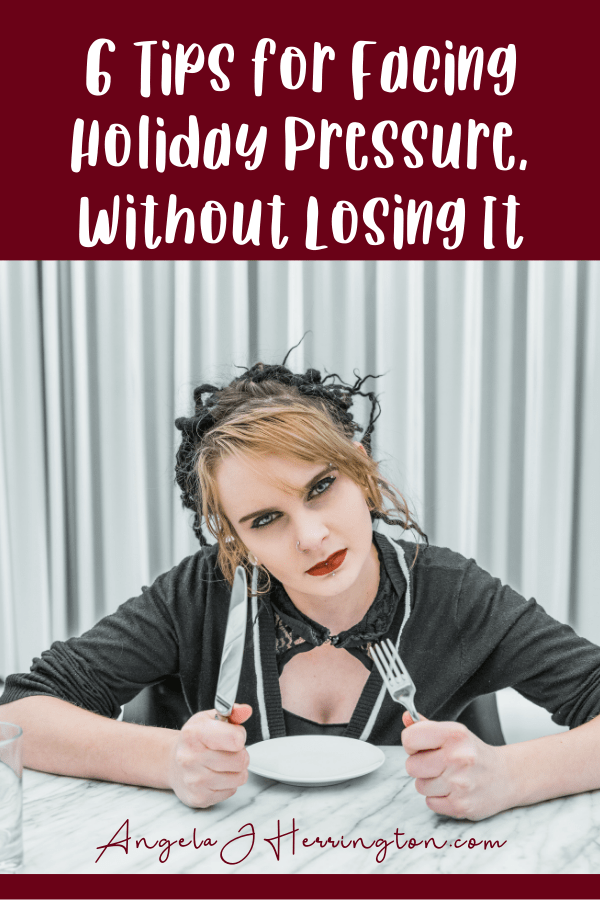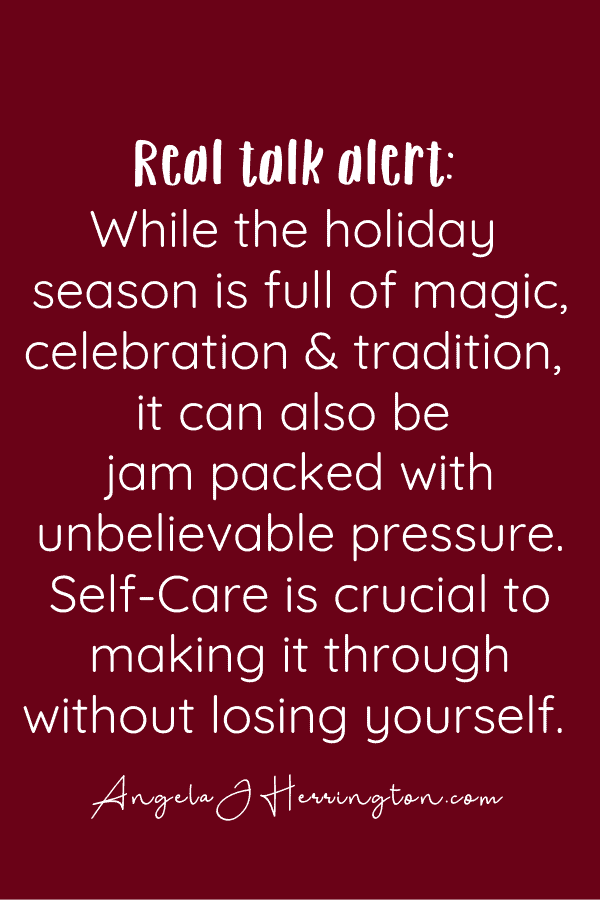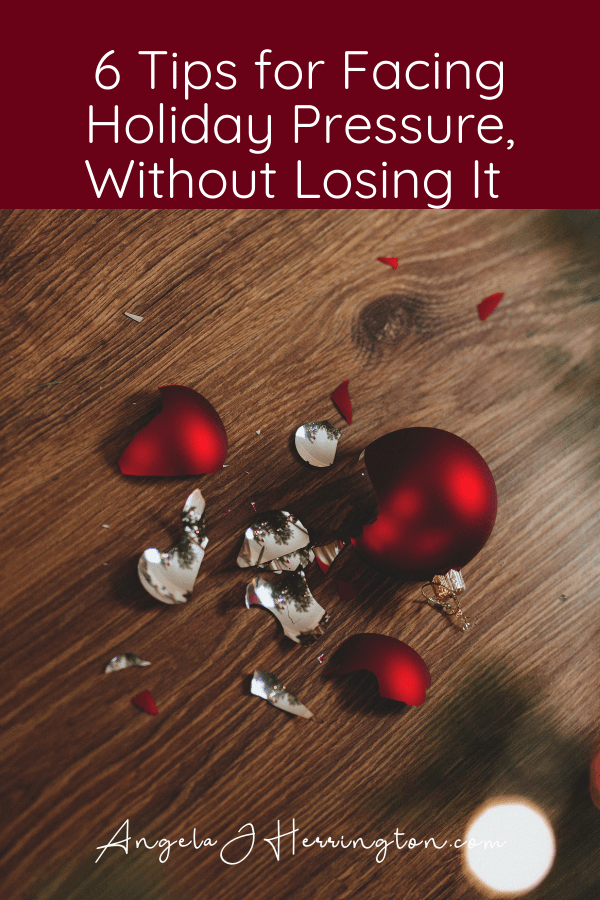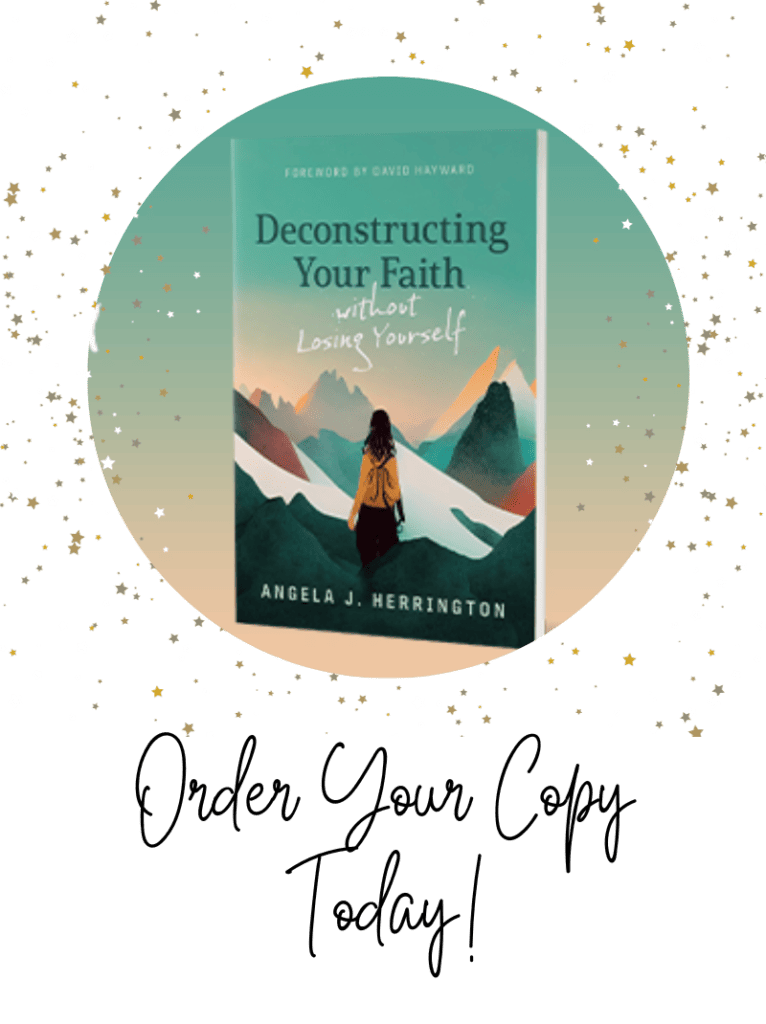Disclaimer:
The tips below are not meant to replace therapy, counseling, or medical treatment. Chronic anxiety, PTSD, depression, and many other illnesses and conditions are best managed under the oversight and advice of a trained professional. If you have concerns about your mental or emotional health, please seek professional support. #normalizetheraphy
Real talk alert: While the holiday season is full of magic, celebration, and tradition, it can also be jam packed with unbelievable pressure.
This pressure comes in all shapes and sizes, and can suck the fun right out of an otherwise joyous season. Pressure might look like tight finances in the midst of expectations around giving gifts to family and friends. It might look like an overfull schedule (or a painfully sparse schedule in the midst of COVID restrictions).
Holiday pressure often means facing old trauma and toxic family relationships that threaten your sense of peace.
The pop ups and sneak attacks ARE THE WORST. You know, the defensive family member who shows up unexpectedly at the party, the song that triggers painful memories, or the elderly family member who keeps pressuring you to keep that handsome, but abusive, ex around because she liked him. When those things catch us off guard, the swell of emotions feels threatening to our body, and the next thing you know you’re flooded with adrenaline.
It’s SUPER important to understand the purposes these emotional reactions serve and not shame ourselves for having them.
So let’s take a second and understand what’s happening here. When we’ve faced trauma, our fight/flight/freeze response gets really good at being on standby (just in case something bad happens again). So if things feel threatening, your body springs into action. It ramps up hormones and crucial organs to help you fight off, run away from, or hide from the source of the threat. (Learn more about the biology of it from this blog post).
This response is meant to help us fight off a serious threat, but what our body doesn’t recognize is that Aunt Bertha’s bad guilt trip isn’t life threatening.
The holiday season is chock-full of pressure ready to trigger your fight/flight/freeze response, but being on edge wears a body (and soul) out. It’s really challenging to get back to a full resting state, but it’s not impossible.
So, as an early Christmas gift to you, I want to share six tips for facing the holiday pressure without losing yourself in the process. I have found that having a ‘canned’ responses I can use when I feel threatened buys me a little time to sort out my emotions and convince my body that I’m OK.
Here are 6 ‘canned’ responses I learned from years of therapy, coaching, fostering, and ministry about dealing with pressure in a healthy, holistic way.
1) Move Your Body.
Movement helps the body push out excess adrenaline and fight feelings of powerlessness. It’s easy to forget this crucial step during seasons with cold weather, as we usually limit ourselves to thinking about movement in terms of taking walks, hiking, or going for a run. But movement is not limited to outdoor activities! It can look like swaying, pacing, tapping, stomping, spinning, and so much more.
The specific movement you choose is up to you! Excusing yourself to go grab a drink or take a restroom break may provide just enough movement to reset. It also removes you from the threat and keeps additional pressure from building. If you aren’t able to move away, try a little movement that shifts your focus away from the threat. Dig in your purse for something, take a drink or bite and chew slowly, or take a few deep breaths. Tapping, fidgeting, and wiggling fingers and toes are great when movement is limited.
The goal is to get the movement you need to burn off that excess energy.
2) Connect with someone or something safe.
Relationships and connection can help if you have people (or even pets) who can be an anchor. Let them know that when anxious your logic brain may be hard to access, so trying to speak to that part of your brain might actually make things worse. Think about how we respond to children when they’ve had a terrifying dream. We respond to their urgent need for safety first, then after the adrenaline has dropped we talk logically about what might help.
You can also reach out to your people for encouragement and long-distance support if you won’t be seeing them. It’s important to remind yourself that there are loving, dependable people in your corner, even if they aren’t at the dinner table for family gatherings.
And if you find yourself spending the holidays without your normal family activities and gatherings (thanks, COVID) make a point of scheduling phone or Zoom calls with people you love. We weren’t meant to live in isolation, and it can be especially hard if we’re missing those important holiday traditions.
The goal is to connect with safe people (or animals) and allow them to help you re-center.
3) Take Your Safe Space on the Road
Safe spaces in our home become our go-to spot when we need more safety. Holiday travel makes that harder, but not impossible. The key is to find specific (portable) things from your safe space that can help you feel grounded, safe, and secure. Be creative when you think about how to bring these allies with you if space is limited. Familiar sights, sounds, textures, and tastes can disrupt the emotional loop triggered by pressure, and point your senses back to peace and calm.
I like to use music, oil blends that I make, or even specific articles of clothing that make me feel secure, calm, and 100% like myself. Blankets, sheets, and even pillowcases from home can give you something familiar to wrap yourself in. Combine these items with slow, intentional breathing and a mantra (like, “I am safe” or “This isn’t permanent”) to maximize their impact!.
The key is to trigger safe, happy feelings that overwhelm that holiday pressure.
4) Develop a Deeper Self-Awareness
Becoming more self-aware in between the high pressure times can give you so much insight and empower you to better manage the unexpected. One of the best ways to address pressure is to do so before you’re triggered. And knowing your patterns so you can prepare is half the battle. It takes the element of surprise away, and helps your brain address the strong emotions more efficiently.
When you are feeling calm ask yourself one or more of these questions to help you identify patterns in your pressure.
When you last felt pressure:
- Where did it show up in your body? (Did you clench your jaw? Hold your breath? Perhaps you woke up with a headache the next day.)
- What were you afraid of?
- What helped you feel like yourself again?
Knowing where it settles in your body will help you know what type of movement or sensory input you need to counteract the pressure. Identifying what you were afraid was gong to happen allows you to scale that fear back to its appropriate size (which is usually smaller than it seems in the moment). Knowing what helped you feel like yourself again helps you know what allies to bring and which members of your circle of support to have on standby during high pressure events.
The goal is to know where pressure binds your body and what you need release it.
5) Practice Mindfulness In The Everyday
The good news is that your mind and body are so resilient and able to learn new things. By adding more skills to your tool box you can teach your body how to respond to pressure in healthy ways. This may seem really challenging, but I promise that’s because most of us were never taught how. The role models we grew up with didn’t know either, so it’s just a big black hole of not knowing.
Mindfulness starts with intently listening to our bodies. During high pressure times, turning our thoughts inward gives our brains something productive to focus on. Practices like yoga, deep breathing, meditation, grounding, and similar activities build your mindfulness muscles. It’s just like learning to play the piano or dribble a basketball. The more you practice, the easier it is to access them when you need help recovering. There are tons of free resources for meditations and breathing (I like this one from my friends at Larks Song).
Mindfulness practices can be both proactive and reactive. When you’re triggered, mindfulness can help restore your calm and sense of self really quickly. But engaging in these practices before the pressure hits maximizes their impact and can be part of an ongoing self-care routine.
Your goal is to have a familiar practice that connects you to a peaceful mindset.
6) Engage in Holistic Self-Care
The absolute best way to face holiday pressure is to go in fully loaded. I highly recommend charging up your emotional, physical, and spiritual reserves with a solid, specific self-care routine. I encourage you to think about your whole person. Take care of your body through good nutrition, medication, and exercise. For Pete’s sake, drink more water and spend less time scrolling social media!
Your mind benefits from stimulation, connection with others, therapy, and engaging in hobbies. And your spirit thrives on intimacy with God and service to others. Think of self-care like working out. The more you fill up your cup, the easier it will be to pour out a little (or a lot) and still have enough for you.
Your goal is a routine that replenishes you BEFORE your tank is empty.
Holiday pressure comes in all shapes and sizes. It may be sneaky, and pop up in an unexpected way. Or the pressure might be predictable, old as time, and still incredibly heavy.
My prayer is that with these tips, you’ll feel confident going into your holiday celebrations.
You are absolutely capable of facing the pressure head on, and coming out intact.




Angela is a Faith Deconstruction Coach and host of The Deconstructing Faith Summit who helps people break free from toxic religious culture & empowers them to recover from #churchhurt. She has led online ministries for a decade, enjoys working with clients 1:1, in groups, and is a dynamic conference speaker. She’s a Lark’s Song Certified Life Coach who reaches thousands of people in 40+ countries each month on Facebook, IG, Twitter, Pinterest, and her blog.
She’s a firstborn, Enneagram 8, Gen Xer who loves to question everything. She holds a BA from Indiana Wesleyan and a Masters in Leadership from Wesley Seminary. Her graduate research project focused on leadership development and opportunities for Gen X women in the US church.
Angela and her unique online ministry are featured in Lyz Lenz’s 2019 book God Land: Story of Faith, Loss, and Renewal in Middle America. She has published articles in Hope for Women and HOPE is Now magazines. She has been featured in The New Republic, Publisher’s Today, and Religion News Service.
Her first book, Deconstructing Your Faith Without Losing Yourself, Will be published by Eerdmans in February 2023.
Angela is also a wife, mom to 5, and a proud resident of Marion, Indiana with her family when they’re not traveling the US in their RV.





